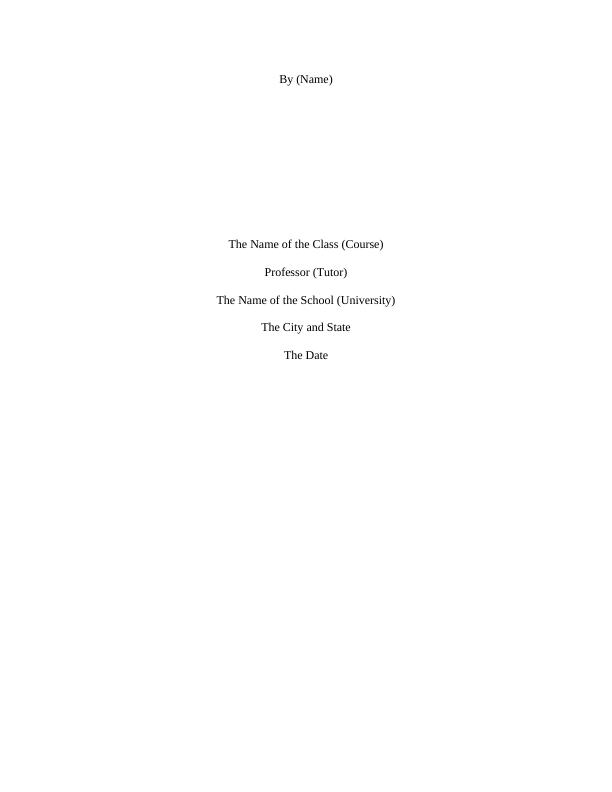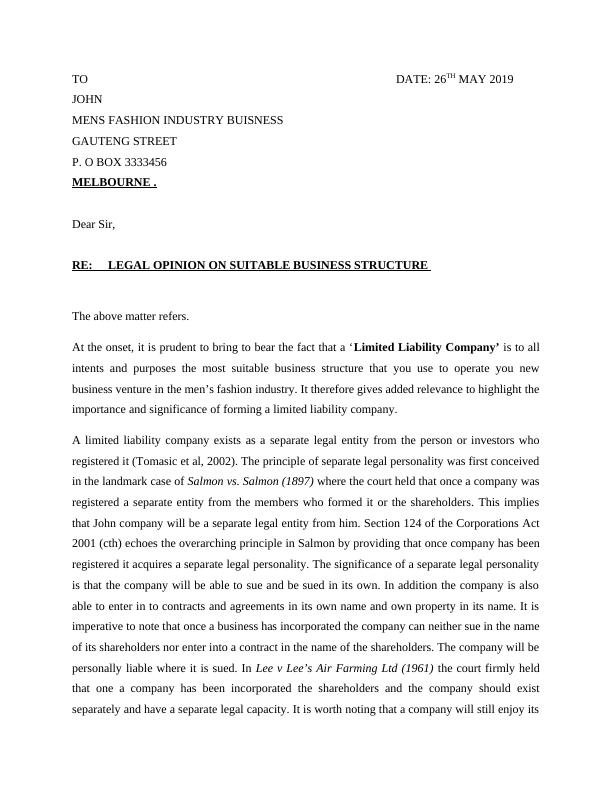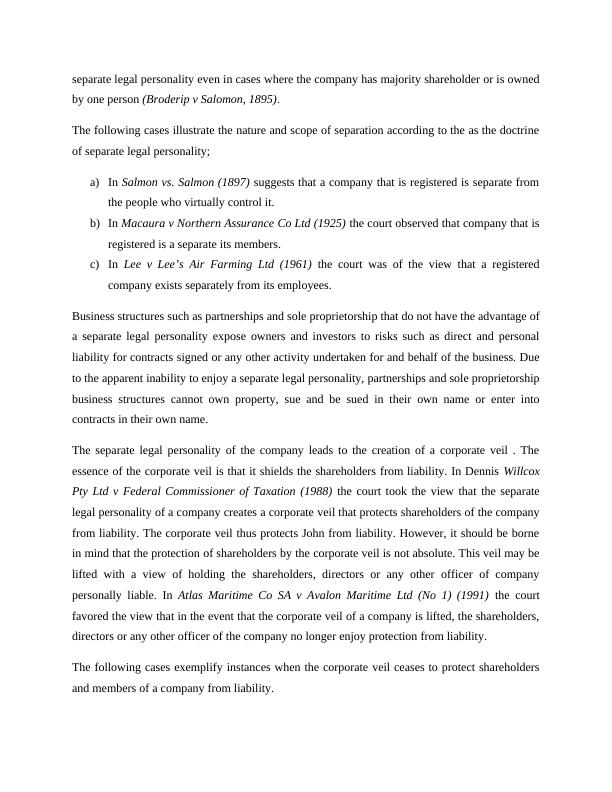Legal Opinion on Suitable Business Structure
Added on 2023-04-03
6 Pages1360 Words362 Views
By (Name)
The Name of the Class (Course)
Professor (Tutor)
The Name of the School (University)
The City and State
The Date
The Name of the Class (Course)
Professor (Tutor)
The Name of the School (University)
The City and State
The Date

TO DATE: 26TH MAY 2019
JOHN
MENS FASHION INDUSTRY BUISNESS
GAUTENG STREET
P. O BOX 3333456
MELBOURNE .
Dear Sir,
RE: LEGAL OPINION ON SUITABLE BUSINESS STRUCTURE
The above matter refers.
At the onset, it is prudent to bring to bear the fact that a ‘Limited Liability Company’ is to all
intents and purposes the most suitable business structure that you use to operate you new
business venture in the men’s fashion industry. It therefore gives added relevance to highlight the
importance and significance of forming a limited liability company.
A limited liability company exists as a separate legal entity from the person or investors who
registered it (Tomasic et al, 2002). The principle of separate legal personality was first conceived
in the landmark case of Salmon vs. Salmon (1897) where the court held that once a company was
registered a separate entity from the members who formed it or the shareholders. This implies
that John company will be a separate legal entity from him. Section 124 of the Corporations Act
2001 (cth) echoes the overarching principle in Salmon by providing that once company has been
registered it acquires a separate legal personality. The significance of a separate legal personality
is that the company will be able to sue and be sued in its own. In addition the company is also
able to enter in to contracts and agreements in its own name and own property in its name. It is
imperative to note that once a business has incorporated the company can neither sue in the name
of its shareholders nor enter into a contract in the name of the shareholders. The company will be
personally liable where it is sued. In Lee v Lee’s Air Farming Ltd (1961) the court firmly held
that one a company has been incorporated the shareholders and the company should exist
separately and have a separate legal capacity. It is worth noting that a company will still enjoy its
JOHN
MENS FASHION INDUSTRY BUISNESS
GAUTENG STREET
P. O BOX 3333456
MELBOURNE .
Dear Sir,
RE: LEGAL OPINION ON SUITABLE BUSINESS STRUCTURE
The above matter refers.
At the onset, it is prudent to bring to bear the fact that a ‘Limited Liability Company’ is to all
intents and purposes the most suitable business structure that you use to operate you new
business venture in the men’s fashion industry. It therefore gives added relevance to highlight the
importance and significance of forming a limited liability company.
A limited liability company exists as a separate legal entity from the person or investors who
registered it (Tomasic et al, 2002). The principle of separate legal personality was first conceived
in the landmark case of Salmon vs. Salmon (1897) where the court held that once a company was
registered a separate entity from the members who formed it or the shareholders. This implies
that John company will be a separate legal entity from him. Section 124 of the Corporations Act
2001 (cth) echoes the overarching principle in Salmon by providing that once company has been
registered it acquires a separate legal personality. The significance of a separate legal personality
is that the company will be able to sue and be sued in its own. In addition the company is also
able to enter in to contracts and agreements in its own name and own property in its name. It is
imperative to note that once a business has incorporated the company can neither sue in the name
of its shareholders nor enter into a contract in the name of the shareholders. The company will be
personally liable where it is sued. In Lee v Lee’s Air Farming Ltd (1961) the court firmly held
that one a company has been incorporated the shareholders and the company should exist
separately and have a separate legal capacity. It is worth noting that a company will still enjoy its

separate legal personality even in cases where the company has majority shareholder or is owned
by one person (Broderip v Salomon, 1895).
The following cases illustrate the nature and scope of separation according to the as the doctrine
of separate legal personality;
a) In Salmon vs. Salmon (1897) suggests that a company that is registered is separate from
the people who virtually control it.
b) In Macaura v Northern Assurance Co Ltd (1925) the court observed that company that is
registered is a separate its members.
c) In Lee v Lee’s Air Farming Ltd (1961) the court was of the view that a registered
company exists separately from its employees.
Business structures such as partnerships and sole proprietorship that do not have the advantage of
a separate legal personality expose owners and investors to risks such as direct and personal
liability for contracts signed or any other activity undertaken for and behalf of the business. Due
to the apparent inability to enjoy a separate legal personality, partnerships and sole proprietorship
business structures cannot own property, sue and be sued in their own name or enter into
contracts in their own name.
The separate legal personality of the company leads to the creation of a corporate veil . The
essence of the corporate veil is that it shields the shareholders from liability. In Dennis Willcox
Pty Ltd v Federal Commissioner of Taxation (1988) the court took the view that the separate
legal personality of a company creates a corporate veil that protects shareholders of the company
from liability. The corporate veil thus protects John from liability. However, it should be borne
in mind that the protection of shareholders by the corporate veil is not absolute. This veil may be
lifted with a view of holding the shareholders, directors or any other officer of company
personally liable. In Atlas Maritime Co SA v Avalon Maritime Ltd (No 1) (1991) the court
favored the view that in the event that the corporate veil of a company is lifted, the shareholders,
directors or any other officer of the company no longer enjoy protection from liability.
The following cases exemplify instances when the corporate veil ceases to protect shareholders
and members of a company from liability.
by one person (Broderip v Salomon, 1895).
The following cases illustrate the nature and scope of separation according to the as the doctrine
of separate legal personality;
a) In Salmon vs. Salmon (1897) suggests that a company that is registered is separate from
the people who virtually control it.
b) In Macaura v Northern Assurance Co Ltd (1925) the court observed that company that is
registered is a separate its members.
c) In Lee v Lee’s Air Farming Ltd (1961) the court was of the view that a registered
company exists separately from its employees.
Business structures such as partnerships and sole proprietorship that do not have the advantage of
a separate legal personality expose owners and investors to risks such as direct and personal
liability for contracts signed or any other activity undertaken for and behalf of the business. Due
to the apparent inability to enjoy a separate legal personality, partnerships and sole proprietorship
business structures cannot own property, sue and be sued in their own name or enter into
contracts in their own name.
The separate legal personality of the company leads to the creation of a corporate veil . The
essence of the corporate veil is that it shields the shareholders from liability. In Dennis Willcox
Pty Ltd v Federal Commissioner of Taxation (1988) the court took the view that the separate
legal personality of a company creates a corporate veil that protects shareholders of the company
from liability. The corporate veil thus protects John from liability. However, it should be borne
in mind that the protection of shareholders by the corporate veil is not absolute. This veil may be
lifted with a view of holding the shareholders, directors or any other officer of company
personally liable. In Atlas Maritime Co SA v Avalon Maritime Ltd (No 1) (1991) the court
favored the view that in the event that the corporate veil of a company is lifted, the shareholders,
directors or any other officer of the company no longer enjoy protection from liability.
The following cases exemplify instances when the corporate veil ceases to protect shareholders
and members of a company from liability.

End of preview
Want to access all the pages? Upload your documents or become a member.
Related Documents
Establishing a Limited Liability Company: Advantages and Duties of Directorslg...
|6
|1776
|76
CO5121 - Plutus Payroll and Associated Companies Case Studylg...
|9
|2966
|119
Application of law Assignment PDFlg...
|6
|1793
|48
LAW 202 : Company Law PDFlg...
|5
|1964
|25
Corporation Business Structure and Legal Personalitylg...
|9
|2443
|91
Liability of a Holding Company for the Negligence of its Subsidiarylg...
|9
|2477
|184
